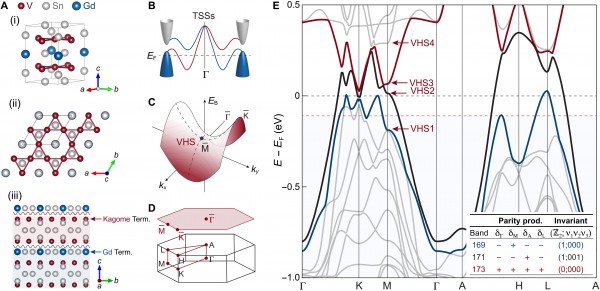Researchers identify, tune novel electronic states in kagome metal GdV6Sn6
by Carey Sargent, EPFL, NCCR MARVEL
Exploring topological physics linked to nontrivial lattice geometries and strong electron interactions is emerging as a new frontier in condensed-matter physics. Realizing and tuning novel electronic states is an area of particular study, given its importance to modern condensed-matter physics and the potential for applications in novel spintronic devices.
Within this field of study, transition-metal-based kagome lattices have attracted much recent attention because their unique geometry appears to be linked to a wide variety of novel phenomena such as correlated topological band structures, magnetism, and diverse exotic electronic instabilities, such as spin liquid states, chiral charge density wave (CDW), and superconductivity.
Researchers have used experimental approaches to investigate topological phenomena in a variety of transition-metal-based kagome magnets as well as in some non-magnetic kagome metals. Various types of topological band crossings (e.g. Dirac and Weyl fermions) have been found. Besides, ℤ2 topology in kagome materials has also been proposed by theoretical calculations, however, identifying and confirming the corresponding topological nature of surface states has remained a challenge because of a lack of good candidate systems. As an example, density functional theory (DFT) calculations indicate that the TDSSs in CsV3Sb5 lie above the Fermi level (EF) and mostly overlap with the projection of bulk states. No clear experimental evidence for ℤ2 TDSSs in kagome materials has therefore been reported to date. Investigations into how these kagaome surface states could be manipulated have also been limited—this is a question that must be answered if the materials are to be used in applications.

Fig. 1. Crystal structure, topological classification, and van Hove singularities in kagome metals GdV6Sn6.
To address these challenges, researchers chose to look at GdV6Sn6, a newly discovered kagome system that has shown magnetic transition at a low temperature of about Tm ~ 5 K. It differs from the other members of the kagome magnet family in that the magnetism is generated by the Gd-triangular lattice, while the kagome layer composed of V and Sn atoms is non-magnetic. The fact that the magnetic and kagome layers are separated allows the scientists to study the electronic structure of the non-magnetic kagome layer directly. This structure also introduces magnetic tunability from the magnetic layer below Tm.
Theory based on band structure calculations suggests that GdV6Sn6 is topologically nontrivial and, in contrast to other such kagome metals, has a large bulk gap around G. This allows the TDSSs to be well separated from bulk states, making the whole system very appealing for accessing and tuning the TDSS, a critical step for exploring potential applications in spintronics. On top of this, multiple VHSs, which are associated with large density of states (DOS) and can enhance correlation effects when a material is at van Hove filling, mean the material serves as a promising platform in the search for exotic correlated states on the kagome lattice. While theory predicts the nontrivial band topology and the great potential for nesting effects in GdV6Sn6, the existence of the TDSSs – as well as the manipulation of the TDSSs and VHSs – had not yet been demonstrated experimentally.
In the paper “Tunable Topological Dirac Surface States and Van Hove Singularities in Kagome Metal GdV6Sn6,” published recently in Science Advances, researchers led by Professor Ming Shi, a senior scientist at the Photon Science Division (PSD) of Paul Scherrer Institute, used a combination of angle-resolved photoemission spectroscopy (ARPES) and DFT calculations to definitively show the characteristic TDSSs in the kagome lattices and identify two types of VHSs at certain points in the paramagnetic phase of GdV6Sn6 – their work thus provides compelling evidence that GdV6Sn6 is a long-sought kagome material that hosts TDSSs originating from the bulk nontrivial ℤ2 topology. What’s more, they were able to directly manipulate the TDSSs and VHSs by depositing potassium on the surface and found that increasing electron doping led to a shifting of the Dirac point of the TDSSs to below the Fermi level from above it. With sufficient doping, the lower branch of the TDSSs can merge into the bulk bands, with only the upper branch crossing the EF, resulting in spin chirality reversal on the Fermi surfaces in the material. Such highly tunable TDSSs show great promise for controlling spin current via local electrostatic gates and deserves further experimental investigation, the researchers said. What’s more, the tunability of the VHSs suggests that it might be possible to realize exotic correlated states on the surface of the material.
Their results not only show that GdV6Sn6 is an interesting platform for further exploring the interplay between the nontrivial band topology, magnetism, and correlation effects of kagome lattices, they also point the way forward for the realization of spintronics devices based on these fascinating materials.
Reference:
Y. Hu, X. Wu, Y. Yang, S. Gao, N.C. Plumb, A.P. Schnyder, W. Xie, J. Ma and M. Shi, Tunable topological Dirac surface states and van Hove singularities in kagome metal GdV6Sn6, Science Advances, 8, 38 (2022)
DOI: 10.1126/sciadv.add2024
Low-volume newsletters, targeted to the scientific and industrial communities.
Subscribe to our newsletter